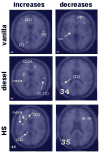Positron tomographic emission study of olfactory induced emotional recall in veterans with and without combat-related posttraumatic stress disorder
- PMID: 17285093
- PMCID: PMC3236699
Positron tomographic emission study of olfactory induced emotional recall in veterans with and without combat-related posttraumatic stress disorder
Abstract
Objective: Memory for odors is often associated with highly emotional experiences, and odors have long been noted by clinicians to be precipitants of trauma symptoms in posttraumatic stress disorder (PTSD). Primitive brain systems involved in fear responsivity and survival also mediate smell, including the olfactory cortex and amygdala. The purpose of this study was to measure neural correlates of olfaction in PTSD.
Methods: We exposed male combat veterans with PTSD (N = 8) and without PTSD (N = 8) to a set of smells, including diesel (related to traumatic memories of combat), and three other types of smells: odorless air, vanilla/coconut, and hydrogen sulfide (H2S) (respectively, a neutral, positive, and negative hedonic nontraumatic smell) in conjunction with PET imaging of cerebral blood flow and assessment of psychophysiological and behavioral symptoms. All subjects also underwent a baseline of olfactory acuity.
Results: PTSD patients rated diesel as unpleasant and distressing, resulting in increased PTSD symptoms and anxiety in PTSD versus combat controls. Exposure to diesel resulted in an increase in regional blood flow (rCBF) in amygdala, insula, medial prefrontal cortex, and anterior cingulate cortex, and decreased rCBF in lateral prefrontal cortex in PTSD in comparison to combat controls. Combat controls showed less rCBF changes on any smell, and did not show amygdala activation upon diesel exposure.
Conclusions: These data support the hypothesis that in PTSD trauma-related smells can serve as strong emotional reminders. The findings indicate the involvement of a neural circuitry that shares olfactory elements and memory processing regions when exposed to trauma-related stimuli.
Figures



References
-
- Herz RS. Emotion experienced during encoding enhances odor retrieval cue effectiveness. Am J Psychol. 1997;110:489–505. - PubMed
-
- Maylor EA, Carter SM, Hallett EL. Preserved olfactory cuing of autobiographical memories in old age. J Gerontol B Psychol Sci Soc Sci. 2002;57:P41–6. - PubMed
-
- Vasterling JJ, Brailey K, Sutker PB. Olfactory identification in combat-related posttraumatic stress disorder. J Trauma Stress. 2000;13:241–53. - PubMed
-
- Dade LA, Zatorre RJ, Jones-Gotman M. Olfactory learning: convergent findings from lesion and brain imaging studies in humans. Brain. 2002;125:86–101. - PubMed
-
- Zald DH, Pardo JV. Functional neuroimaging of the olfactory system in humans. Int J Psychophysiol. 2000;36:165–81. - PubMed
Publication types
MeSH terms
Grants and funding
LinkOut - more resources
Full Text Sources
